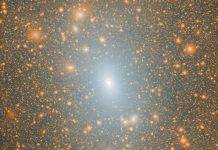
Did you know that planets, stars, and even whole galaxies have magnetic fields?
Yep, even our Milky Way galaxy has a giant magnetic field!
But there’s still a lot we don’t know about how these magnetic fields are formed and why they’re important.
A team of astronomers has just made an exciting discovery that gives us some clues.
They found a magnetic field in a galaxy so far away that it took its light more than 11 billion years to reach us!
This means we’re seeing this galaxy as it was when the universe was only 2.5 billion years old.
This awesome finding was made using a special telescope called the Atacama Large Millimeter/submillimeter Array (ALMA).
James Geach, a professor from the UK and the lead researcher, said that this is big news because, until now, we’ve mostly looked at magnetic fields in galaxies that are close to us.
So this discovery is like finding an old family photo that helps us understand our roots.
Enrique Lopez Rodriguez from Stanford University, who also worked on the study, said we still have lots of questions about how these magnetic fields get started and how they change over time.
This new discovery gives us a glimpse into the past and helps us understand that galaxies can have fully formed magnetic fields even when they are very young.
So, what’s so special about this faraway galaxy’s magnetic field? For starters, it’s pretty weak compared to Earth’s magnetic field—about 1,000 times weaker. But it’s huge! It stretches over 16,000 light-years.
Finding a magnetic field in a galaxy from so long ago tells us that these fields can form pretty quickly. And the team thinks that lots of stars forming in the early universe could speed up the process.
Rob Ivison, an astronomer who worked on the study, says that understanding these magnetic fields can help us learn more about how stars are made. When stars form, they can be influenced by the magnetic fields around them.
So how did they find this magnetic field? They used ALMA to look for a specific kind of light that comes from dust grains in galaxies.
When a magnetic field is around, these dust grains line up in a certain way, and the light they give off has a special pattern.
Scientists call this “polarized” light. ALMA found this special light coming from this faraway galaxy, named 9io9, and that’s how they knew it had a magnetic field.
“No other telescope could have achieved this,” said Geach. This discovery is just the beginning. Scientists hope that by studying more faraway magnetic fields, they’ll start to solve the mystery of how these important features in galaxies come to be.
So the next time you look up at the night sky and wonder about all those stars and galaxies out there, remember that they’re not just balls of gas and dust—they’re complex systems with their own magnetic fields, and each discovery we make helps us understand a little more about how our universe works.
Follow us on Twitter for more articles about this topic.
Source: ESO.



